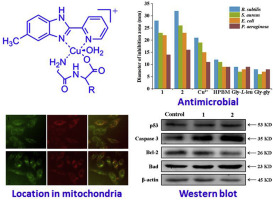European Journal of Medicinal Chemistry ( IF 6.0 ) Pub Date : 2018-05-21 , DOI: 10.1016/j.ejmech.2018.05.023 Yong-Yu Qi , Qian Gan , Ya-Xian Liu , Ya-Hong Xiong , Zong-Wan Mao , Xue-Yi Le

|
In the search for more effective anticancer drugs with less toxic side effects, dipeptides were introduced into the Cu(II) complex of 5-methyl-2-(2′-pyridyl)benzimidazole (HPBM). Analytical and spectroscopic techniques were employed to thoroughly characterize complexes [Cu(Gly-gly)(HPBM)(H2O)]ClO4·0.5H2O (1) and [Cu(Gly-L-leu)(HPBM)(H2O)]ClO4 (2) (where Gly-gly = Glycyl-glycine anion, Gly-L-leu = Glycyl-l-leucine anion). The solution stability studies performed by ultraviolet–visible (UV–Vis) spectroscopy confirmed the stability of the complexes in the buffer solutions. The DNA binding affinity was evaluated using multi-spectroscopy, viscosity measurement and molecular docking methods and further quantified by Kb and Kapp values, revealing an intercalative mode. Moreover, gel electrophoresis analysis revealed that the complexes could damage CT DNA through a hydroxyl radical pathway in the presence of ascorbic acid. All the complexes displayed favorable antimicrobial and cytotoxic activities toward the tested microorganisms (Bacillus subtilis, Staphylococcus aureus, Escherichia coli and Pseudomonas aeruginosa) and cancer cells (A549, HeLa and PC-3). Most importantly, the possible anticancer mechanism of the complexes was explored by determining the cells morphological changes, intracellular reactive oxygen species (ROS) levels, location in mitochondria, mitochondrial membrane potentials and the expression of Bcl-2 family proteins. The results showed that the complexes could induce apoptosis in HeLa cells through an ROS-mediated mitochondrial dysfunction pathway, which was accompanied by the regulation of Bcl-2 family proteins.
中文翻译:

基于5-甲基-2-(2'-吡啶基)苯并咪唑的两种新型铜(II)二肽配合物作为潜在的抗菌药物和抗癌药:对其可能的抗癌机制进行了特殊探索
为了寻找更有效的抗癌药物,且毒副作用较小,将二肽引入了5-甲基-2-(2'-吡啶基)苯并咪唑(HPBM)的Cu(II)配合物中。采用分析和光谱技术对配合物[Cu(Gly-gly)(HPBM)(H 2 O)] ClO 4 ·0.5H 2 O(1)和[Cu(Gly- L -leu)(HPBM)( ħ 2 O)] CLO 4(2)(其中,甘氨酸-甘氨酸=甘氨酰-甘氨酸阴离子,Gly-大号-leu =甘氨酰-升-亮氨酸阴离子)。通过紫外-可见(UV-Vis)光谱进行的溶液稳定性研究证实了缓冲液中复合物的稳定性。使用多光谱,粘度测量和分子对接方法评估了DNA结合亲和力,并进一步通过K b和K app值进行定量,揭示了嵌入模式。此外,凝胶电泳分析表明,在抗坏血酸存在下,复合物可能通过羟自由基途径破坏CT DNA。所有复合物对所测试的微生物(枯草芽孢杆菌,金黄色葡萄球菌,大肠杆菌)均表现出良好的抗菌和细胞毒活性。和铜绿假单胞菌)和癌细胞(A549,HeLa和PC-3)。最重要的是,通过确定细胞的形态变化,细胞内活性氧(ROS)水平,线粒体中的位置,线粒体膜电位和Bcl-2家族蛋白的表达,探索了该复合物可能的抗癌机制。结果表明,该复合物可通过ROS介导的线粒体功能障碍途径诱导HeLa细胞凋亡,并伴随Bcl-2家族蛋白的调控。











































 京公网安备 11010802027423号
京公网安备 11010802027423号